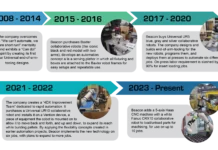by John Pizzo, Sun Plastech Inc.
A huge volume of plastic resin is wasted every day due to poor resin quality, color changes, and product contamination. This large amount of plastic scrap creates a significant drain on the efficiency and profitability of thermoplastic processors already under pressure from a weakened economy. Plastics processors have reacted to this challenge by introducing new management and quality enhancement techniques, as well as a variety of new materials and equipment. Companies not evolving to meet these challenges are going out of business or being consumed by those that do progress. One significant change in the thermoplastics processing industry is the growing acceptance of commercial purging compounds.
Why Use Purging Compounds?
The need for effective purging of processing machinery has recently increased in importance. Some problems confronting processors include increased frequency of material changes due to an increased number of grades/colors of resins; intensifying efforts of high quality competition; a shortage of experienced operators; increased cost and difficulty of waste disposal; and an increase in customer demand for a wide variety of just-in-time, customized products. As a result, there are many opportunities at the processing site to reduce costs by increasing the focus on purging operations.
Purging of processing equipment with a minimum quantity of material, in a minimal amount of time, and at the lowest total cost has become the most significant element to influence the competitiveness of many processors. For example, reducing the time required to purge a 350-ton injection molding press (assuming $85/hour cost) by just 10 minutes per day results in a savings of over $3,000 per year!
It was about 30 years ago when the first commercial purging compound appeared on the market, but it was not until the mid-1990s that sales for these products began rapid growth. Until recently, the most popular method of purging had been using processing materials such as the next resin or scrap. However, this method is like washing clothes with only water, instead of using laundry detergent to remove non-water-soluble stains. With this method, the loss of time and material can be huge. Additionally, contaminants tend to develop during long production runs. It is reasonable to accept that scrap or the next resin, just like washing with only water, cannot purge such contamination problems like carbonized resin. If natural resins could remove decomposed resins, contamination would be removed continuously from the machine, rather than increasing during the course of a production run. As a result of this prolonged residence of resins in a machine, degradation and defects are likely. Just as detergents are indispensable for washing clothes, a high-performance purging compound should be indispensable in thermoplastics processing plants.
Another effective use of some types of purging compounds is as a sealant during machine shutdowns. Sealing with these purging compounds not only prevents carbon formation but also actively removes it during machine shutdown. It facilitates faster set-up when starting the machine and reduces the scrap resin and rejects typical during startup. The purging compound supplier should be consulted to see if its product can be used for shutdown and sealing.
Evaluating Purging Compounds
There is a large number of purging compound products available today. Most fit into one of the following categories: material affinity, cast acrylic, cast acrylic with carrier, chemical reaction, surfactant, and blends of polyethylene with active ingredients. These categories vary widely by ingredients, mode of functionality, performance, and cost. Though the total cost of the purging process must be considered in selecting a purging compound, there are several factors that a processor should evaluate when choosing a purging compound:
- Cleaning power – The amount (weight) of purging compound required for elimination of all unwanted resin or contamination from the system.
- Residue – The amount (weight) of the next resin required to eliminate the purging compound entirely from the system being purged.
- Ease of use – Procedures required for effective product use should be minimal and simple to perform.
- Environmental friendliness – The purging compound should not have adverse effects on the operating personnel, plant equipment, the environment, or the physical properties of the finished product.
As for the total cost, it should include not only the cost of the purging compound, but also the amount of time required for the purge (translated into a downtime cost) and the amount of scrap resin and parts generated while purging. A cost savings analysis, which should be performed by the purging compound supplier, will show the total cost of using a purging compound and the resulting cost savings.
Most thermoplastics processing facilities would benefit by using a commercial purging compound instead of scrap or the next resin, despite their apparent low cost. To properly evaluate the actual cost-effectiveness of a purging compound, all cost factors must be considered, including material, machine, labor, lost production, scrap handling/reprocessing, waste disposal, and customer satisfaction. These cost savings may range from as little as 1 percent to as much as 5 percent added to the bottom line. Without effective purging techniques, it is unlikely that any plastics processor will remain economically viable in the increasingly competitive global marketplace.
Sun Plastech Inc. is the leading manufacturer and distributor of ASACLEAN® purging compound for thermoplastic injection machines and extruders, serving North and South America. Sun Plastech is backed by the technology and resources of its parent company and one of the world’s leading chemical companies, Asahi Kasei Chemicals Corp. It is the largest core operating company of Asahi Kasei Group, a technology-based global company with over 70 years of experience in materials science. Asahi Kasei is an ISO 9001 and ISO 14001 certified company. For more information, call (800) 787-4348, email sales@asaclean.com, or visit www.asaclean.com.




